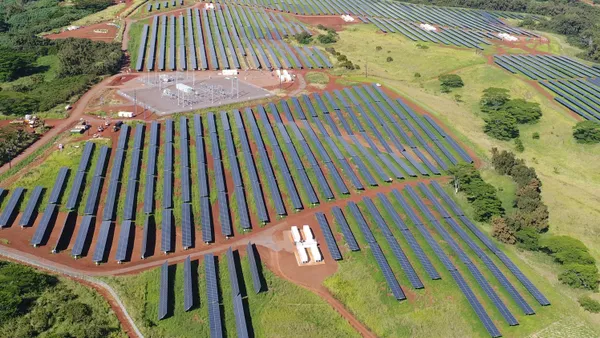Dive Brief:
-
The U.S. Bureau of Land Management on Wednesday unveiled an updated solar roadmap that proposes opening 22 million acres for developing utility-scale solar on public land in 11 Western states.
-
The proposal refines the BLM's existing maps of land open to solar development in Arizona, California, Colorado, Nevada, New Mexico and Utah, and adds new maps of potential development areas in Idaho, Montana, Oregon, Washington and Wyoming, according to a press release from the U.S. Department of the Interior.
-
The BLM has proposed six alternative roadmaps with varying degrees of protection for critical habitat and cultural resources, but the preferred option appears to include lands previously ruled unsuitable for solar development, according to Kevin Emmerich, co-founder of Basin and Range Watch, a Nevada-based conservation group.
Dive Insight:
The BLM's newly proposed roadmap for solar development on Western public lands should direct development away from sensitive cultural and natural resources and toward areas with better transmission line access, according to the agency, but not everyone is convinced.
The BLM used $4.3 million in funding from the Inflation Reduction Act to work with the National Renewable Energy Laboratory and other stakeholders to develop the proposed roadmap. According to the agency, NREL determined that 700,000 acres of public lands will be needed to meet national needs and goals for renewable energy deployment. The agency's preferred roadmap, which restricts development to areas within 10 miles of existing or planned transmission, would open 22 million acres to applications by solar developers.
Alternative roadmaps proposed by the BLM would open 8.4 million acres to 55 million acres to solar energy development.
“The Interior Department’s work to responsibly and quickly develop renewable energy projects is crucial to achieving the Biden-Harris administration’s goal of a carbon pollution-free power sector by 2035 — and this updated solar roadmap will help us get there in more states and on more lands across the West,” Laura Daniel-Davis, acting U.S. Deputy Secretary of the Interior, said in a statement.
The Wilderness Society welcomed the news in Wednesday statement, saying that “smart, responsible project siting” would benefit communities, decrease impacts to the environment and help solar deploy more rapidly.
“Renewable energy on public lands can be a win-win-win. Better tribal engagement, better community buy-in and lower impact siting leads to faster, better projects,” said Justin Meuse, director of government relations for energy and climate at The Wilderness Society. “We need a Western Solar Plan that meets our energy needs while honoring the other vital roles public lands play for wildlife, people and our shared future in the era of climate change. It’s imperative and it’s possible.”
But Emmerich said that based on his preliminary review of the more-than-500-page document, the BLM has proposed to open regions such as the Amargosa Valley in Nevada to solar development. The Environmental Protection Agency has objected to solar development in the Amargosa Valley in the past, citing concern that the area does not have sufficient groundwater available to support solar development. Solar farms can use considerable quantities of water to control dust, Emmerich said.
Opening pristine public lands to solar development is taking the easy way out when the nation should be focused on reducing energy use and installing solar on rooftops, over parking lots and on previously disturbed land such as old mine sites, Emmerich said.
An alternative contained in the BLM's proposal that would restrict solar development to previously disturbed lands within 10 miles of existing or proposed applications would open just under 8.4 million acres to solar applications.
But the Solar Energy Industries Association noted in a statement that even the BLM's preferred 22 million acre plan would represent a mere fraction of the acreage available to oil and gas developers.
“Under the current policy, there are at least 80 million acres of federal lands open to oil and gas development, which is 100 times the amount of public land available for solar,” Ben Norris, SEIA vice president of regulatory affairs, said. “BLM’s proposal is a big step in the right direction and recognizes the key role solar plays in our energy economy.”













